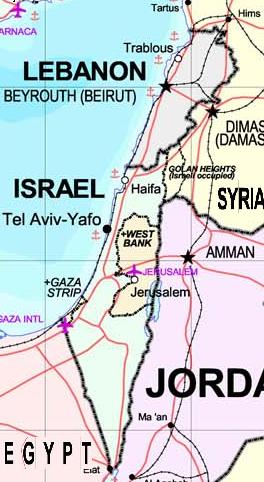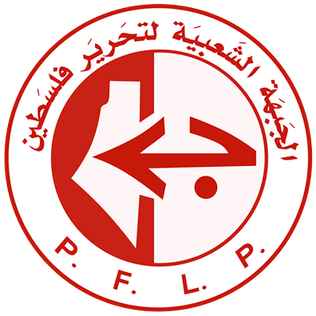
Yasser Arafat, also popularly known by his kunya Abu Ammar, was a Palestinian political leader. He was chairman of the Palestine Liberation Organization (PLO) from 1969 to 2004 and president of the Palestinian National Authority (PNA) from 1994 to 2004. Ideologically an Arab nationalist and a socialist, Arafat was a founding member of the Fatah political party, which he led from 1959 until 2004.

The Popular Front for the Liberation of Palestine – General Command or PFLP-GC is a Palestinian nationalist militant organisation based in Syria.

The 1982 Lebanon War began on 6 June 1982, when Israel invaded southern Lebanon. The invasion followed a series of attacks and counter-attacks between the Palestine Liberation Organization (PLO) operating in southern Lebanon and the Israeli military that had caused civilian casualties on both sides of the border. The military operation was launched after gunmen from the Abu Nidal Organization attempted to assassinate Shlomo Argov, Israel's ambassador to the United Kingdom. Israeli Prime Minister Menachem Begin blamed Abu Nidal's enemy, the PLO, for the incident, and used the incident as a casus belli for the invasion.

The Lebanese Civil War was a multifaceted armed conflict that took place from 1975 to 1990. It resulted in an estimated 150,000 fatalities and also led to the exodus of almost one million people from Lebanon.

Black September, also known as the Jordanian Civil War, was an armed conflict between Jordan, led by King Hussein, and the Palestine Liberation Organization (PLO), led by chairman Yasser Arafat. The main phase of the fighting took place between 16 and 27 September 1970, though certain aspects of the conflict continued until 17 July 1971.
The War of the Camps, was a subconflict within the 1984–1990 phase of the Lebanese Civil War, in which the Palestinian refugee camps in Beirut were besieged by the Shia Amal militia.
The Rejectionist Front or Front of the Palestinian Forces Rejecting Solutions of Surrender was a political coalition formed in 1974 by radical Palestinian factions who rejected the Ten Point Program adopted by the Palestine Liberation Organization (PLO) in its 12th Palestinian National Congress (PNC) session.

The Israeli–Lebanese conflict, or the South Lebanon conflict, is a series of military clashes involving Israel, Lebanon and Syria, the Palestine Liberation Organization, as well as various militias and militants acting from within Lebanon. The conflict peaked in the 1980s, during the Lebanese Civil War, and has abated since.

The South Lebanon conflict, designated by Israel as the Security Zone in Lebanon Campaign, was a protracted armed conflict that took place in southern Lebanon from 1985 to 2000. It saw fighting between Israel and the Catholic Christian-dominated South Lebanon Army (SLA) against Hezbollah-led Shia Muslim and left-wing guerillas within the Israeli-occupied "Security Zone"; the SLA had military and logistical support from the Israel Defense Forces over the course of the conflict and operated under the jurisdiction of the Israeli-backed South Lebanon provisional administration, which succeeded the earlier Israeli-backed State of Free Lebanon. It can also refer to the continuation of the earlier conflict in this region involving the growing Palestinian insurgency in South Lebanon against Israel following the expulsion of the Palestine Liberation Organization (PLO) from Jordan after Black September. Historical tensions between Palestinian refugees and Lebanese factions contributed another layer to the Lebanese Civil War (1975–1990), which saw the Maronite-led Lebanese Front and the Shia Amal Movement at war with the PLO. Hence, the South Lebanon conflict can partly be seen as an extension of the civil war that ended in 1990.

The Lebanese National Resistance Front, best known by its Arabic acronym, ‘Jammoul’ (جمول), was a leftist alliance active in Lebanon in the 1980s. It acted as a successor to the Lebanese National Movement, which ceased to exist after the Israeli invasion of Lebanon.

Palestinian fedayeen are militants or guerrillas of a nationalist orientation from among the Palestinian people. Most Palestinians consider the fedayeen to be "freedom fighters", while most Israelis consider them to be "terrorists".

Ainab, is a town on the western slopes of Mount Lebanon overlooking Beirut. It is in the Aley District of the Mount Lebanon Governorate 25 kilometres (16 mi) from Beirut, on the road South from Aley.
The Front for the Liberation of Lebanon from Foreigners (FLLF), or Front pour la Libération du Liban des Étrangers (FLLE) in French, was a formerly obscure underground militant organization that surfaced in Lebanon at the early 1980s.

The Palestinian insurgency in South Lebanon was a multi-sided armed conflict initiated by Palestinian militants against Israel in 1968 and against Lebanese Christian militias in the mid-1970s. It served as a major catalyst for the outbreak of the Lebanese Civil War in 1975. Fighting between the Palestinians and the Christian militias lasted until the Israeli invasion of Lebanon in 1982, which led to the expulsion of the Palestine Liberation Organization (PLO) from Lebanese territory. While the PLO relocated to Tunisia in the aftermath of Israel's invasion, other Palestinian militant factions, such as the Syria-based PFLP–GC, continued to carry out low-level operations from Syrian-occupied Lebanon. After 1982, the insurgency is considered to have faded in light of the inter-Lebanese Mountain War and the Israel–Hezbollah conflict, the latter of which took place for the duration of the Israeli occupation of South Lebanon.

The Popular Front for the Liberation of Palestine (PFLP) is a secular Palestinian Marxist–Leninist and revolutionary socialist organization founded in 1967 by George Habash. It has consistently been the second-largest of the groups forming the Palestine Liberation Organization, the largest being Fatah.

The Democratic Front for the Liberation of Palestine is a secular Palestinian Marxist–Leninist and Maoist organization. It is also frequently referred to as the Democratic Front, or al-Jabha al-Dīmūqrāṭiyya. It is a member organization of the Palestine Liberation Organization, the Alliance of Palestinian Forces and the Democratic Alliance List.

During the 1982 Lebanon War, the city of Beirut was besieged by Israel following the breakdown of the ceasefire that had been imposed by the United Nations amidst the Lebanese Civil War. Beginning in mid-June, the two-month-long siege resulted in the expulsion of the Palestinian Liberation Organization (PLO) from Beirut and the rest of Lebanon.
The Battle of Tripoli was a major battle during the middle of the Lebanese Civil War in late 1983. It took place in the northern coastal city of Tripoli between pro-Syrian Palestinian militant factions and the Palestine Liberation Organization (PLO) led by Yassir Arafat. It resulted in the withdrawal of PLO and mostly ended their involvement in the war.











